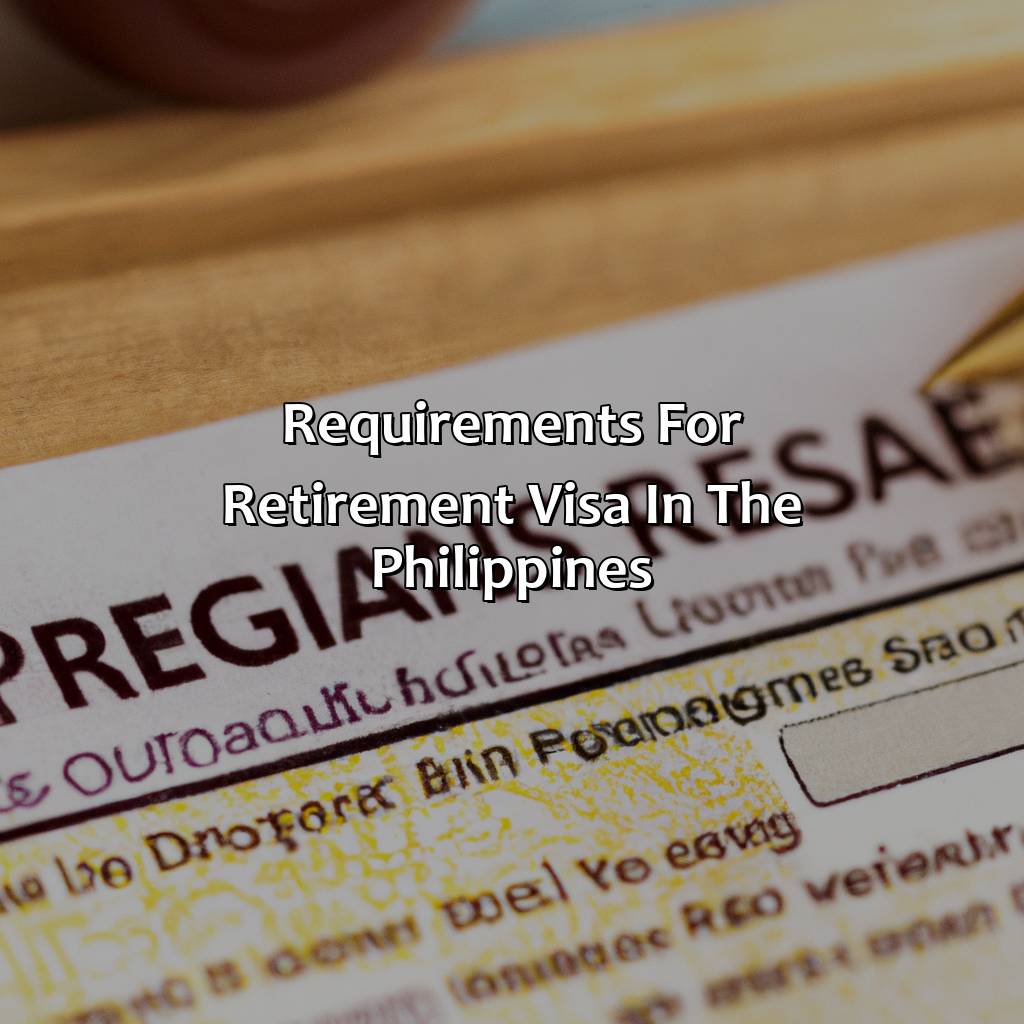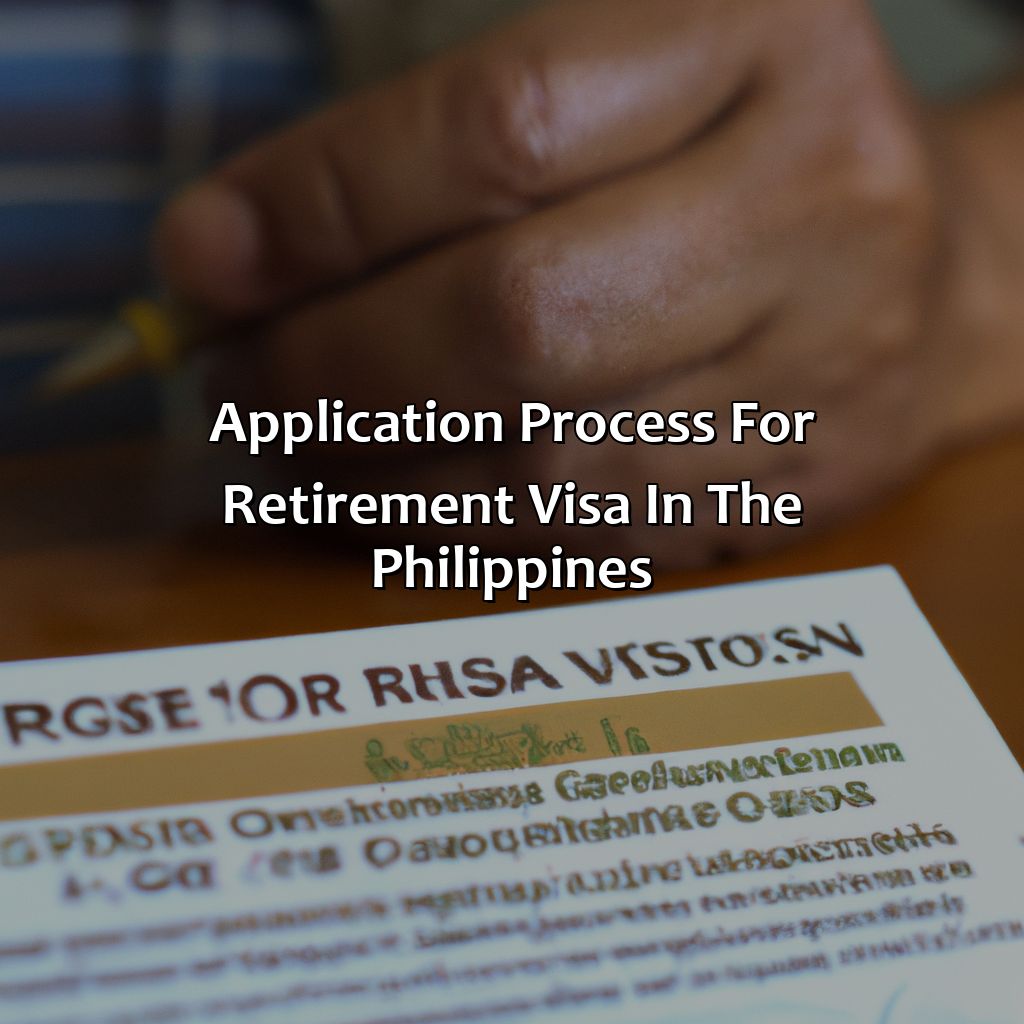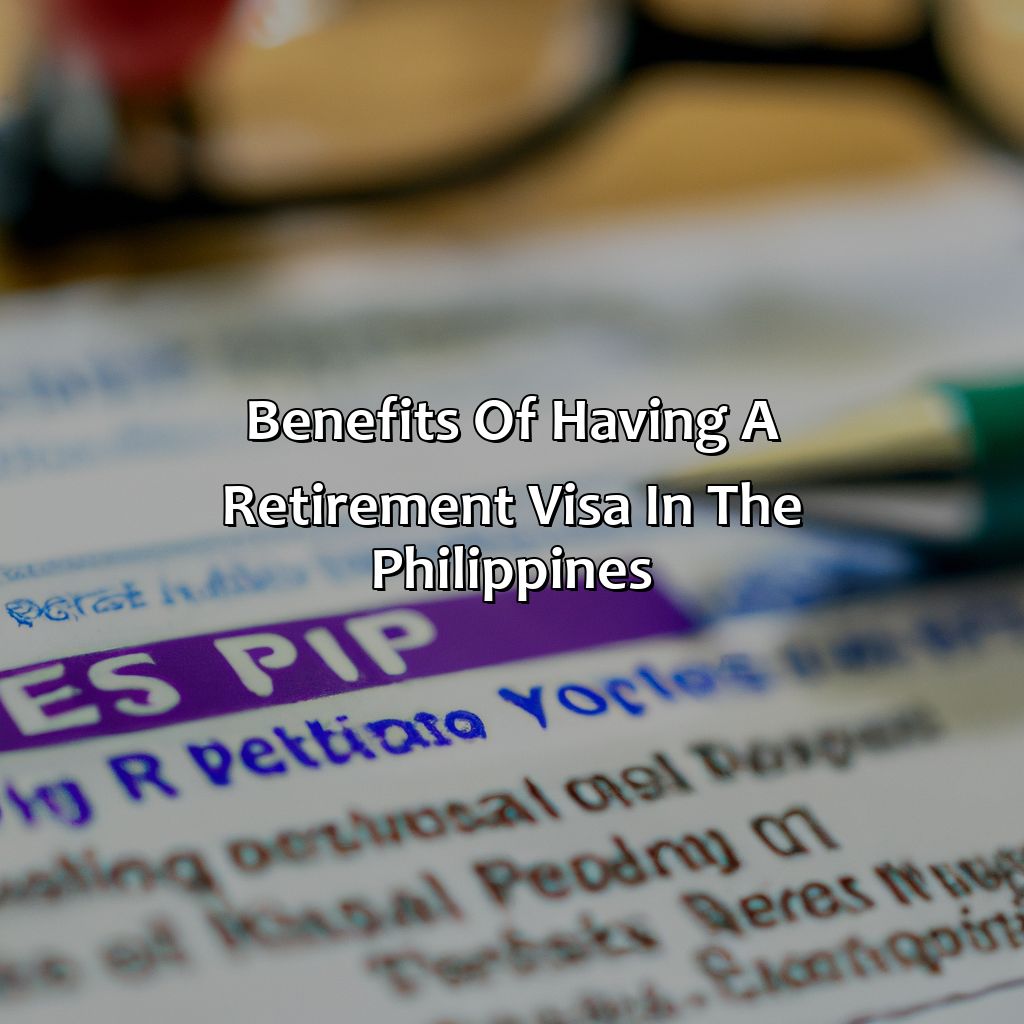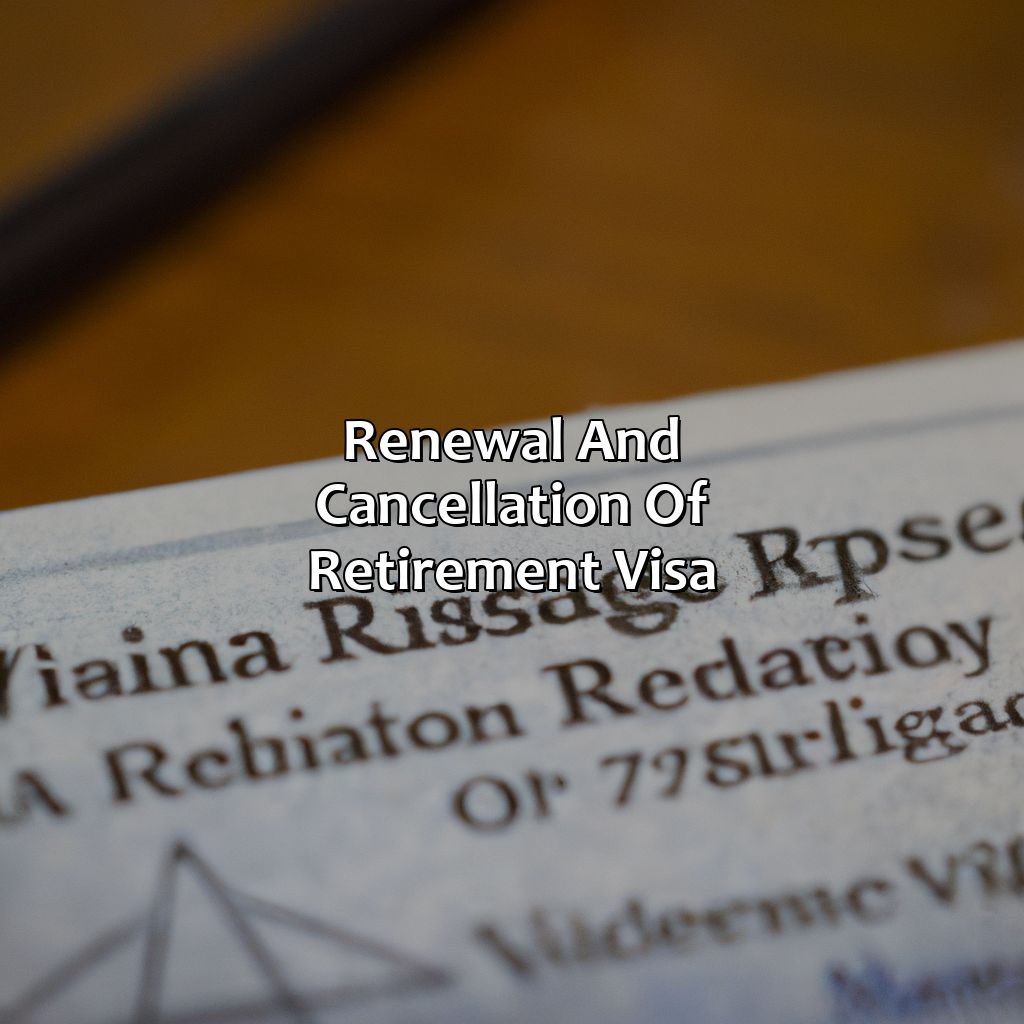How Do I Get A Retirement Visa In The Philippines?
Key Takeaway:
- Age, financial capacity, and health and insurance requirements must be met to qualify for a retirement visa in the Philippines.
- Prepare the necessary documents and submit them to the Philippine Bureau of Immigration to begin the application process.
- The benefits of having a retirement visa in the Philippines include tax exemptions and discounts, access to healthcare and other services, and the ability to receive foreign currency remittance.
Are you thinking of retiring in the Philippines? Do you want to know how to get a retirement visa? You’ll get the answers you need in this article. Learn how to plan your retirement and secure the right visa to make your move to the Philippines a reality.
Requirements for Retirement Visa in the Philippines
If you wish to get a retirement visa in the Philippines quickly, then you have to meet several conditions. We will take a closer look at the age, financial capacity, and health & insurance requirements that need to be satisfied in order to get a retirement visa.

Image credits: retiregenz.com by Harry Duncun
Age Requirement
Retirement Visa Age Criteria
To acquire a retirement visa in the Philippines, one must have reached the age of 35 or above. The Philippine Bureau of Immigration offers two kinds of visas – Special Resident Retiree’s Visa (SRRV) and Non-Quota Immigrant Visa.
The SRRV is open to all retirees over the age of 35 who wish to obtain residency in the Philippines. The Non-Quota Immigrant Visa is for those who have family members that are either citizens or permanent residents already residing in the country.
Moreover, applicants must be able to provide supporting documentation such as proof of financial stability and medical clearance.
There was an elderly couple from Australia I met during my stay in the Philippines who were on retirement visas. They shared that while at first it was difficult for them to adjust, they eventually fell in love with the country’s culture and friendliness of people.
Money talks, and for a retirement visa in the Philippines, it needs to speak at least $10,000 – and that’s just for starters.
Financial Capacity Requirement
To satisfy the financial requirement for a retirement visa in the Philippines, applicants must show proof of a monthly pension or retirement income of at least $1,500. This is to ensure that they have the financial capacity to support themselves without becoming a burden on the country’s resources.
Additionally, applicants who do not have a regular source of income may also qualify if they can demonstrate sufficient net worth. In this case, they must provide documentation showing assets with a minimum value of $50,000 and an additional $10,000 per dependent.
It’s worth noting that while these are the minimum requirements for financial capacity, some Philippine embassies or consulates may require higher amounts. Applicants should check with their local embassy or consulate for specific details.
Pro Tip: It’s recommended to have more than the minimum required amount saved up as unexpected expenses can arise during one’s stay in the Philippines.
Don’t wait until retirement to start taking your health seriously – the Philippine government won’t let you in without it.
Health and Insurance Requirement
As part of the process to obtain a retirement visa in the Philippines, individuals must meet certain health and insurance requirements. These requirements vary based on age and medical history, but typically include obtaining health insurance from an accredited Philippine company. This insurance should cover both hospitalization and outpatient services.
Additionally, retirees may be asked to provide proof of their physical fitness, which can be done through a medical exam or certificate from their physician. This ensures that they are fit to travel and live independently in the Philippines.
To avoid any last-minute issues with the health and insurance requirements for the retirement visa, it is best to research and choose a reliable provider ahead of time. This will help ensure that you have sufficient coverage for your medical needs while living in the Philippines.
It is also recommended that retirees take advantage of preventive care services offered by their chosen healthcare provider. Regular check-ups and screenings can help identify any potential health issues early on, allowing for prompt and effective treatment.
Step aside, all ye who seek visas… the retirement visa application process in the Philippines has arrived, slow and steady, like retirees at a buffet.
Application Process for Retirement Visa in the Philippines
Retirement visa application for the Philippines? You gotta go through the process! Get the documents ready, submit the application to the Philippine Bureau of Immigration. Then you gotta wait for the processing and approval of your visa application. Boom!

Image credits: retiregenz.com by James Woodhock
Preparation of Required Documents
To ensure a smooth application process for retirement visa in the Philippines, arranging the necessary documents is crucial. Required documents include proof of adequate financial means such as bank statements or annuity papers and police clearance, among others.
Additionally, applicants must prepare their passport along with a medical report from an authorized medical facility certifying that they have no communicable diseases. Moreover, providing proof of health insurance coverage upon arrival in the Philippines is mandatory.
The Philippine Bureau of Immigration requires documentation to be thorough and up-to-date to avoid delayed processing. Therefore, it’s essential to secure all required documents at least two months before arriving in-country.
Pro Tip: Make sure to double-check the authenticity of your documents by consulting with an immigration lawyer or accredited visa agent for a more efficient application process.
As if standing in line at the DMV isn’t bad enough, now imagine doing it in the tropical heat of the Philippines to submit your retirement visa application.
Submission of Application to the Philippine Bureau of Immigration
To apply for a Retirement Visa in the Philippines, you need to submit your application to the Philippine Bureau of Immigration. Here is a step-by-step guide to help you through the process.
- Ensure that you have met all the eligibility requirements, such as being at least 35 years old and having an adequate pension or retirement fund.
- Complete your online application form on the Bureau of Immigration’s website or visit the nearest Philippine Embassy or Consulate.
- Submit your application form with all necessary supporting documents, such as proof of income and health insurance.
- Pick up your ACR-I Card (Alien Certificate of Registration) upon arrival in the Philippines from any port where there is a Bureau of Immigration office.
- Pay the necessary fees for processing your visa and ACR-I Card at any authorized payment center or bank.
- Attend an interview at a designated Bureau of Immigration office if required. You will be notified if you need to attend an interview after submitting your application.
It’s important to note that processing times may vary, so it’s best to apply well ahead of time before arriving in the country. For more information on this subject matter, it’s advisable to check with relevant authorities.
In summary, getting a Retirement Visa in the Philippines requires careful preparation and timely submission of documents. Don’t hesitate to seek professional help should you encounter difficulties during any stage of this process.
If patience is a virtue, then the Philippines retirement visa process will turn you into a saint.
Processing and Approval of Retirement Visa
The process of applying for a retirement visa in the Philippines involves fulfilling specific requirements set by the Bureau of Immigration. Applicants are required to submit various documents, including proof of retirement income and valid health insurance coverage. Additionally, applicants must complete medical examinations, obtain police clearance, and submit biometric data. Once all requirements have been fulfilled and fees paid, the application is processed by the Bureau of Immigration. Approval or denial is granted after thorough review.
It is essential to note that while some retired foreign nationals can enter the Philippines without obtaining a visa, it is prudent to apply for a retirement visa before traveling to avoid any hassles at entry points. Applications can be submitted before arrival in the Philippines or through one of many accredited agencies that assist with processing and approval.
Finally, retirees may find it useful to seek advice from professionals or retired expatriates already living in the Philippines regarding suitable locations and accommodation options. It’s also necessary to learn about existing healthcare resources within their chosen location as there are differences between medical facilities available for public healthcare versus private care options.
Retiring in the Philippines comes with the added bonus of being referred to as a ‘senior citizen’, which is both flattering and mildly concerning at the same time.
Benefits of Having a Retirement Visa in the Philippines
Gain insight into the perks of a retirement visa in the Philippines! Tax exemptions and discounts, healthcare, services, and foreign currency remittance are the features. Learn how these sub-sections make your retired life in the Philippines more comfortable. No more hassle!

Image credits: retiregenz.com by Adam Washington
Tax Exemptions and Discounts
Tax incentives for retirees in the Philippines can ease financial stress.
- Exempted from paying travel tax
- No taxes on pensions and annuities from foreign sources
- Tax-free importation of personal effects worth up to $7,000
- 50% discount on theatre fees, movies, and cultural events
- A 20% discount for medical-related expenses covering doctors’ services, dental services, diagnostic and laboratory tests, and professional fees.
Retirement visa holders also get a tax incentive for charitable donations made while residing in the country.
Philippines news source ABS-CBN News reports that “the government just imposed a P10 tax increase on cigarettes.”
Retire to the Philippines for access to healthcare and other services, because who needs stress when you’re supposed to be enjoying your golden years?
Access to Healthcare and Other Services
Access to essential services like healthcare, transportation, communication and banking can be accessed easily by retirees who have secured a retirement visa in the Philippines. From affordable medical care to English-speaking doctors— these services cater to foreign retirees.
Other services like utilities, domestic help and shopping centers are also readily available in retirement communities. Retirees can comfortably live and enjoy their lives without worrying about access to basic amenities.
Moreover, having a local bank account with a retirement visa provides easy access to finance management. Nearly all banks in the country offer online banking services ensuring convenient bill payments and money transfers back home.
Pro Tip: Before settling down in the Philippines, ensure your home is located near hospitals or clinics for unexpected emergencies.
Sending money back home just got easier, thanks to the Philippines’ retirement visa.
Foreign Currency Remittance
Facilitating the Transfer of International Funds
One significant concern for foreign retirees in the Philippines is how to transfer their international funds. To address this concern, the Philippine government allows foreign retirees to open a bank account that permits them to receive their pension directly from their countries of origin. This arrangement makes it convenient for retirees to manage their finances comfortably.
Moreover, with the opening of a local bank account, foreign retirees can execute foreign currency remittance with ease. This benefit eliminates unnecessary expenses on currency conversion and transfer fees charged by third-party providers. They can also monitor transactions online and make quick transfers when necessary.
It’s worth noting that local banks have partnered with reputable institutions worldwide to facilitate remittance services. The Bangko Sentral ng Pilipinas (Central Bank of the Philippines) regulates all foreign exchange transactions and ensures compliance with global regulations.
Philippines has been known as one of the top destinations for expats because of its beautiful tourist spots, affordable living costs, hospitable locals and many more reasons. However, transferring funds in a timely and secure manner remains crucial for retirees’ peace of mind.
Retirement in the Philippines: Where you can cancel your visa and your dinner reservations with equal ease.
Renewal and Cancellation of Retirement Visa
Renewing or cancelling your retirement visa in the Philippines? You need to meet certain requirements. Plus, there are certain reasons for visa cancellation that you must know. This section on “Renewal and Cancellation of Retirement Visa” covers it all! Let’s dive into the details of these sub-sections.

Image credits: retiregenz.com by Joel Jones
Requirements and Process for visa Renewal
When a foreign national seeks to continue their stay in the Philippines, they can apply for the renewal of their visa. The process and requirements for visa renewal must be strictly followed to avoid any complications during the application process.
- Begin the renewal process at least one month before your visa’s expiry date.
- Secure all necessary documentation, including a valid passport with a minimum six months validity left, completed application forms, and passport-sized photos.
- Submit the documents to the Bureau of Immigration (BI) in person or through an authorized representative or courier service.
- Pay the appropriate fees and obtain an acknowledgment receipt.
- Wait for the BI to process your application. You will receive either an approval or denial via email or text message.
- If approved, obtain your new visa from BI and ensure that it is updated in all your relevant documentation.
It is worth noting that failure to renew your visa on time could result in fines and penalties and may even lead to deportation. It is also possible to apply for multiple renewals as long as you continue to meet all requirements.
Visa renewal requires careful attention to detail, but it is an essential part of staying legally in the Philippines. When it comes to renewing visas, every step should be taken seriously.
Recently, a retiree overstayed his visa due to unforeseen circumstances despite submitting a timely renewal application. He was allowed entry after paying necessary fees but learned about stringent rules regarding visa extensions’s due process.
Reasons for visa Cancellation and How to Avoid it.
To ensure the longevity of your retirement visa in the Philippines, it’s crucial to understand the possible reasons for its cancellation and how to avoid them. One way is to ensure that you comply with all the requirements necessary for renewals, such as maintaining a valid ACR I-Card and securing an ECC before leaving the country.
Additionally, violations such as engaging in unauthorized work or overstaying can result in visa cancellation. To avoid these violations, always consult with your embassy or immigration office regarding any activities you intend to do. It’s also essential to keep track of your visa’s expiration date and apply for renewal at least a month before it expires.
Furthermore, it’s critical to maintain good behavior while staying in the country, avoiding any confrontations with authorities or locals. Finally, seek legal assistance if ever there are issues concerning your visa status.
By adhering to these guidelines and being vigilant about compliance and behavior, you can help prevent any risk of visa cancellation that could disrupt your retirement plans in the Philippines. So stay informed and proactive in ensuring your visa remains valid and secure throughout your stay in this beautiful country.
Five Facts About How To Get A Retirement Visa In The Philippines:
- ✅ The Philippine Retirement Authority offers two types of retirement visas: the SRRV Classic and the SRRV Smile. (Source: Philippine Retirement Authority)
- ✅ To be eligible for the SRRV Classic, applicants must be at least 35 years old and have a pension worth at least $1,500 a month. (Source: Philippine Retirement Authority)
- ✅ For the SRRV Smile, applicants must be at least 50 years old and deposit $20,000 in a Philippine bank. (Source: Philippine Retirement Authority)
- ✅ Both types of retirement visas allow for multiple-entry and indefinite stays in the Philippines. (Source: Philippine Retirement Authority)
- ✅ Retirement visa holders can enjoy several benefits, such as waived exit and re-entry permit fees, special import and exchange rates, and tax exemption on pension and annuities. (Source: Philippine Retirement Authority)
FAQs about How Do I Get A Retirement Visa In The Philippines?
What is a retirement visa in the Philippines?
A retirement visa in the Philippines is a special type of visa that allows foreigners who are at least 35 years old to stay in the country as a retiree. This visa allows the holder to live and stay in the Philippines as long as they want without the need for further visa applications.
How do I qualify for a retirement visa in the Philippines?
To qualify for a retirement visa, you must be at least 35 years old and be able to show proof of a pension or retirement income of at least $1,500 per month. You must also not have a criminal record and be in good health. All other requirements can be found on the official website of the Philippine embassy.
How do I apply for a retirement visa in the Philippines?
To apply for a retirement visa in the Philippines, you must go to the Philippine embassy in your home country or the Bureau of Immigration in the Philippines. You will need to submit the required documents, including proof of your pension or retirement income and a medical clearance certificate, among others.
How long is the processing time for a retirement visa in the Philippines?
The processing time for a retirement visa in the Philippines varies depending on the embassy or consulate where you are applying. It can take anywhere from a few days to a few weeks for your application to be processed.
Can I work with a retirement visa in the Philippines?
No, a retirement visa in the Philippines does not allow you to work. If you want to work in the Philippines, you will need to apply for a work visa instead.
Can my spouse also get a retirement visa in the Philippines?
Yes, as long as you meet the requirements, your spouse can also apply for a retirement visa in the Philippines. They will need to submit their own application and provide their own proof of retirement income.




